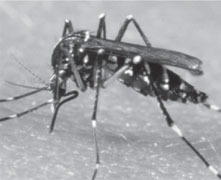|

Mapping exercise to determine hotspots :
Dengue, an epidemic worldwide
By Nilma DOLE
Contracting dengue has almost become inevitable and the Health
Ministry is taking serious action against those who have contributed to
the dengue epidemic by not disposing of their rubbish the proper way.
However, arresting people won't really check the dengue problem as the
real solution has to come from within the people to really make a
difference. Irrespective of caste, creed, social standing or money,
dengue affects anybody and can strike at any time.
 Discipline and willingness to make a change is the order of the day
and if we don't think of keeping our environment clean or disposing
rubbish the proper way, it will be ultimately we who suffer. Discipline and willingness to make a change is the order of the day
and if we don't think of keeping our environment clean or disposing
rubbish the proper way, it will be ultimately we who suffer.
Dengue has been spreading not only in Sri Lanka, but from Pakistan to
Puerto Rico and also from Singapore to the Philippines. It's hard to
imagine what was termed as a dengue outbreak in Sri Lanka is now a
world-wide epidemic.
The biggest problem is that there is no cure for it even though
research has been done in Brazil where a Dengue Vaccine is produced. It
involves an economic analysis of producing a tetravalent dengue vaccine
shows that the cost would be low with an annual production level of 60
million doses packaged in ten-dose vials.
But the highlight is on prevention through effective rubbish
management and checking mosquito breeding grounds in urban and sub-urban
areas. A study of potential risk of dengue disease outbreak in Sri Lanka
using GIS (Graphical Interface System) and statistical modelling by
Sumith Pathirana concludes amongst other things that there is a definite
relationship between the incidence of dengue and the monthly rainfall
pattern. Also, many believe that a cyclical pattern occurs that is
related to rainfall events.
Rainfall figures
According to Sri Lankan research, rainfall figures show that 2005 and
2008 were wetter years and (although we might expect the reverse) in
those years the transmission of dengue fever reduced. The conclusion we
can draw is that when there are heavy rains and flooding, dengue
breeding grounds are washed away and breeding levels diminish. When the
rains are intermittent the breeding rates are higher, thus giving the
conclusion that rainfall, mosquito breeding and the collection of
stagnant water are directly proportionate to the dengue epidemic.
 In Sri Lanka, dengue is primarily active in the Western Province
(three main administrative regions: Colombo, Gampaha and Kalutara), with
emphasis on the city of Kandy. There are several reasons of this as it
is the most densely populated and most heavily urbanised part of the
country, and so the disease can be passed easily and quickly. In Sri Lanka, dengue is primarily active in the Western Province
(three main administrative regions: Colombo, Gampaha and Kalutara), with
emphasis on the city of Kandy. There are several reasons of this as it
is the most densely populated and most heavily urbanised part of the
country, and so the disease can be passed easily and quickly.
In the first quarter of 2012, there were about 12, 000 cases of
reported dengue with 53 deaths. In the past, children and the elderly
were mainly at risk, but recent analysis shows that this situation is
changing.
In 1998, 80 percent of all dengue transmissions were found in the
under-15 age group. Ten years later 65 percent of transmissions were
found in people over 15 years of age. Currently the ratio is
approximately 60/40 in favour of the over 15 with the 20 to 34 age group
being the most affected.
However, dengue is still not fully understood and people still
underestimate its effects with a negative attitude with "It can't
possibly happen to me!" Then disaster hits when they battle for life and
death against this deadly disease.
A victim of dengue usually has a high fever that lasts for more than
two weeks which can be mistaken for the viral flu as it has similar
symptoms. However, doctors now advise that even if a victim has flu, it
is important that they check their blood to be on the safe side as it
can be the start of dengue.
The common symptoms include high fever, sometimes as high as 40°C
with severe headache, muscle and joint pains and vomiting. In most cases
it is not fatal, but as with influenza it can result in extended periods
of hospitalisation and rehabilitation.
However, dengue haemorrhagic fever, (DHF) a related viral infection,
is much more dangerous and can result in internal bleeding and death.
In the 19th century it was considered a sporadic disease, but today,
dengue fever and dengue haemorrhagic fever rank as one of the most
important mosquito-borne viral diseases in the world.
An estimated 2.5 billion people live in over 100 endemic countries
and areas where dengue viruses can be transmitted. Up to 50 million
infections occur annually with 500,000 cases of dengue hemorrhagic fever
and 22,000 deaths mainly among children. The mosquito that carries the
virus needs to have access to stagnant water for part of its breeding
cycle hence it is absent from the arid regions of North Africa.
Once a person has recovered from a viral attack they have lifetime
immunity to that particular viral strain. There are no drugs to combat
the virus and so treatment is restricted to the use of paracetamol to
reduce pain, rehydration therapy and blood transfusions.
There are a number of actions that can be taken to control the
transmission of the virus especially through preventing and eradicating
mosquito breeding sites. More than the removal of rubbish, repairing and
regular maintenance of storm drains and sewerage systems need to be
done.
Viral attack
The Health authorities in Colombo are planning to set up a
Colombo-wide G.I.S. mapping exercise to determine the pattern of
transmission to determine hotspots of the disease with a view to
identifying the major breeding areas prior to treatment.The authorities
have begun to take steps to combat Dengue but the Aedes aegypti mosquito
is an adaptable insect. Control options are limited and the mosquito is
proving very difficult to eradicate.
The eggs can withstand long periods of desiccation and cannot be
killed by conventional means. Of concern is that standard methods are
failing to reduce the incidence of dengue in tropical communities
everywhere, not just in Sri Lanka.
There are biological controls in the form of an aquatic bug
Diplonychus indicus has been shown to be an efficient predator of
mosquito larvae and pupae. In field tests larvae and pupae populations
were reduced by between 95 and 98 percent.
The guppy fish, which feeds on the larvae, has been used in Pakistan
but can only be used in aquatic environments. The bacterial parasite
Wolbachia, has been shown to reduce the lifespan of the mosquito by
increasing its vulnerability to infections and hence to be very
effective in reducing mosquitos. Not only is this nature-friendly but it
doesn't have severe consequences to the health of residents in the long
run.
In 2011 out of 28,473 cases reported there were only 185 deaths and
overall mortality rates per thousand are currently around 0.1 percent.
However Morbidity rates are much higher, over of 0.5 percent per
thousand.
This is important for two reasons, namely the higher rates of
morbidity have a negative impact on the quality of life and the negative
effects of the virus can leave people feeling unwell for months.
This in turn would have an impact, for example on the Health Adjusted
Life Expectancy for the country.
The rise in dengue is tending to be found increasingly amongst young
Sri Lankan adults this will adversely affect productivity and could slow
down Sri Lanka's recovery.
References : P.Brighty, Epidemiology Unit, Sri Lanka and World
Health Organisation
Researchers make headway:
Proteins regulate immune system
 Researchers in the biological sciences department in the Faculty of
Science at the University of Calgary have revealed how white blood cells
move to infection or inflammation in the body; findings which could help
lead to developing drug therapies for immune system disorders. Researchers in the biological sciences department in the Faculty of
Science at the University of Calgary have revealed how white blood cells
move to infection or inflammation in the body; findings which could help
lead to developing drug therapies for immune system disorders.
It's long been known that two human proteins - L-selectin and
calmodulin - are involved in moving white blood cells to the site of
inflammation or infection in the body. L-selectin is embedded in the
cellular membrane of the white blood cells and acts like Velcro,
tethering the white blood cell to the sticky surface on the wall of the
blood vessel.
When the white blood cell reaches a site of infection or
inflammation, it 'sheds' the L-selectin protein, which lets it leave the
blood stream and enter the damaged tissue. This shedding process is
controlled inside of the white blood cell by the protein calmodulin.
"Cell biologists had figured out in 1998 that calmodulin was
negatively regulating the shedding process of L-selectin," says Jessica
Gifford, a PhD student supervised by Hans Vogel. "They knew calmodulin
did it, but they didn't know how."
Using powerful magnets and a technique called nuclear magnetic
resonance (NMR) spectroscopy, Gifford and Vogel determined the molecular
structure of the interaction between the two proteins, providing
important insight at the molecular level into how calmodulin controls
the shedding of L-selectin.
"Understanding the molecular details of these processes will help us
understand how our bodies respond to inflammation," says Gifford, "and
if we can understand that, that's the first step of producing drug
therapies to manipulate your immune system, to either turn it on, or
turn it off." There is a growing interest in drug therapies to help
regulate the immune system, say GIfford.
"So many problems that people have are due to overactive immune
systems," she says. "By understanding how your white blood cells get
around, then maybe we can stop them from getting there when they don't
need to be."
- MNT
Nerve regrowth protein identified
A protein needed to re-grow injured nerves in limbs has been
identified, raising the prospect of new treatments.
The findings, in mice, have implications for helping patients recover
from peripheral nerve injuries. They also open new pathways for
investigating how to regenerate neurons in the spinal cord and brain.
Peripheral nerves provide the sense of touch and drive the muscles
that move the arms, legs and feet.
Unlike the central nervous system nerves of the spinal cord, they can
regrow after being cut or crushed. But how this happens is still not
well understood.Scientists conducting the new research, reported in the
journal Neuron, identified a signalling protein that helps switch on the
regeneration process.
The molecule, called leucine zipper kinase (DLK), regulates signals
that tell a nerve cell it has been injured, often communicating over
distances of several feet. Mice lacking DLK were unable to regrow
severed nerves. Lead researcher Prof Aaron DiAntonio, from Washington
University in St Louis, US said: "DLK is a key molecule linking an
injury to the nerve's response to that injury, allowing the nerve to
regenerate.
"How does an injured nerve know that it is injured? How does it take
that information and turn on a regenerative program and regrow
connections? And why does only the peripheral nervous system respond
this way, while the central nervous system does not? We think DLK is
part of the answer."Understanding the role of DLK may also be relevant
to the central nervous system, say the researchers. "Since this sort of
signalling doesn't appear to happen in the central nervous system, it's
possible these nerves don't 'know' when they are injured," said Prof
DiAntonio."It's an exciting idea - but not at all proven - that
activating DLK in the central nervous system could promote its
regeneration."
- PA
Secret of how to live longer? Eat 40 percent less, say scientists
A group of scientists is developing a treatment to combat the
"disease" of ageing. They aim to keep people younger for longer by
studying fruit flies, which share 60 percent of human genes and age in
remarkably similar ways.
 The Institute of Health Ageing at University College London is
studying genetics and lifestyle factors, particularly diet, to develop
treatment to combat ageing. The Institute of Health Ageing at University College London is
studying genetics and lifestyle factors, particularly diet, to develop
treatment to combat ageing.
Matthew Piper, one of the key members of the team working at the
institute, said: "If we discover the genes involved with ageing, we
should be able to delay ageing itself. This is what we've found."
The scientists have been using modified diets and drug treatments to
prolong healthy lifespan in flies and mice. They say the results
indicate such treatments might have beneficial effects for humans.
However, the field, which is only 10 years old, is "all theoretical
at the moment", Dr Piper added. "There is no timeline on when it could
be used for humans."The team contend the treatments will also tackle
age-related diseases, such as cardiovascular disease, cancer and
neurodegeneration.
Dr Piper said: "We take the novel approach of viewing these chronic
illnesses as being symptoms of a common underlying problem: ageing
itself.
If ageing can be treated, can we offset the diseases that come with
it? It's not just about living longer, it's about living healthy."
The research is carried out studying yeast, worms and flies. Fruit
flies age in a similar way to humans. "It's very easy to spot how old
flies react. They fall over a lot.
They don't walk as fast, they eat less, their memory declines as does
their sex drive. These are all associated with human ageing," Dr Piper
said.
Scientists have successfully extended the life of organisms in the
lab by mutating single genes and have shown they can lessen the effects
of a mutation which can cause Alzheimer's. Another way to extend life is
to target the diet. Dr Piper said: "If you reduce the diet of a rat by
40 percent it will live for 20 or 30 percent longer. So we would be
talking 20 years of human life.
This has shown on all sorts of organisms, even labradors."
Another Royal Society exhibit will explain how facial features are
determined by genetic make-up and why a child may have a nose like their
father or mouth like their mother.
A team from the University of Leicester is also studying genetics to
see if some smokers are predisposed to a higher level of lung disease.
The exhibits include the dynamics of avalanches; studies of
undiagnosed cardiac conditions; the science of laughing; and genetically
modifying mosquitos.
There is even a team of robots designed to play football.
- The Independent
Risk for depression increased by childhood adversity
 When a person injures his or her knee, it becomes inflamed. When a
person has a cold, the throat becomes inflamed. This type of
inflammation is the body's natural and protective response to injury. When a person injures his or her knee, it becomes inflamed. When a
person has a cold, the throat becomes inflamed. This type of
inflammation is the body's natural and protective response to injury.
Interestingly, there is growing evidence that a similar process
happens when a person experiences psychological trauma. Unfortunately,
this type of inflammation can be destructive.
Previous studies have linked depression and inflammation,
particularly in individuals who have experienced early childhood
adversity, but overall, findings have been inconsistent. Researchers
Gregory Miller and Steve Cole designed a longitudinal study in an effort
to resolve these discrepancies, and their findings are now published in
a study in Biological Psychiatry.
They recruited a large group of female adolescents who were healthy,
but at high risk for experiencing depression.
The volunteers were then followed for 2 1/2 years, undergoing
interviews and giving blood samples to measure their levels of
C-reactive protein and interleukin-6, two types of inflammatory markers.
Their exposure to childhood adversity was also assessed.
The researchers found that when individuals who suffered from early
childhood adversity became depressed, their depression was accompanied
by an inflammatory response.
In addition, among subjects with previous adversity, high levels of
interleukin-6 forecasted risk of depression six months later. In
subjects without childhood adversity, there was no such coupling of
depression and inflammation. Dr. Miller commented on their findings:
"What's important about this study is that it identifies a group of
people who are prone to have depression and inflammation at the same
time. That group of people experienced major stress in childhood, often
related to poverty, having a parent with a severe illness, or lasting
separation from family. As a result, these individuals may experience
depressions that are especially difficult to treat."
Another important aspect to their findings is that the inflammatory
response among the high-adversity individuals was still detectable six
months later, even if their depression had abated, meaning that the
inflammation is chronic rather than acute. "Because chronic inflammation
is involved in other health problems, like diabetes and heart disease it
also means they have greater-than-average risk for these problems.
They, along with their doctors, should keep an eye out for those
problems," added Dr. Miller.
- NYT
|

